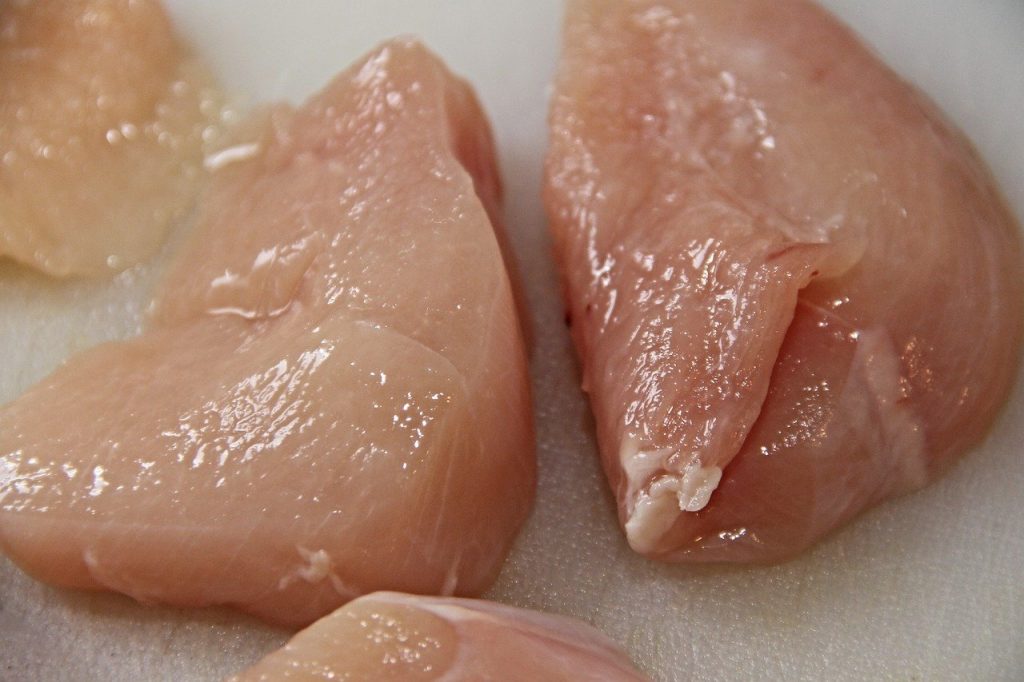[Article updated on 19/09/2023]
Chicken breast is a high-protein, low-fat meat. It is an element of many dishes due to its speed of preparation and delicate flavor. This low-calorie product contains many minerals necessary for the proper functioning of the body. Let’s see together how many calories chicken breast contains.
How many calories are in chicken breast?
100 g of raw chicken breast provides the body with only 98 Kcals. It is therefore a low-calorie product.

Chicken fillet is considered lean meat. The calorific value of the prepared dish changes due to heat treatment. 100 grams of boiled chicken breast provides 98 kcals, while baked it is worth 134 kcals. 100 grams of fried chicken breast without breading is worth 239 kcals. Breaded, this same quantity will be worth 268 kcals. Therefore, you should pay special attention to the preparation method and choose less harmful cooking for weight loss.
Protein, carbohydrate and lipid content of chicken breast
The amount of protein in 100 g of chicken breast is 21.5 g and the amount of fat is 1.3 g. Chicken breast fits perfectly into the principles of a digestible diet, because once cooked it does not irritate the intestines. Skinless white meat is ideal for people with high cholesterol because it contains only 58 mg of cholesterol per 100 grams. It’s worth comparing it with beef, which contains up to 90 mg of cholesterol.
Nutritional values table for chicken breast
| Nutrients | Chicken breast: content per 100 grams |
| Carbohydrates | 0g |
| -with sugar | 0g |
| -of which starch | 0g |
| -including dietary fiber | 0g |
| Proteins | 31g |
| Lipids | 3.57g |
| -including cholesterol | 85 mg |
| -of which saturates | 1.01g |
| Potassium | 256 mg |
| Sodium | 74 mg |
| Water | 65.3g |
How much does a chicken breast weigh on average?
A medium-sized chicken breast weighs 205g and provides around 200kcals. For this reason, it is eagerly chosen by people following a slimming diet.
Mineral and vitamin content
Chicken breast is a good source of minerals and vitamins. Half a fillet contains:
- 385 mg of potassium;
- 33 mg of magnesium;
- 0.4 mg of iron;
- 0.49 mg zinc;
- 0.1 mg of copper;
- 0.1 mg of manganese;
- 0.09 mg thiamine (vitamin B1);
- 0.153 mg riboflavin (vitamin B2);
- 12.44 mg niacin (vitamin B3);
- 0.55 mg pyridoxine (vitamin B6);
- 0.4 mg of cobalamin (vitamin B12).
Fillet is a good source of B vitamins, essential for the proper functioning of the nervous and circulatory systems. By consuming chicken breasts, we also replenish minerals such as iron, magnesium, selenium and zinc.
An average breast fillet weighing 200 g covers 85% of the daily vitamin B6 requirement and 85% of the selenium requirement of an average adult.
Does chicken breast make you gain weight?
Due to its nutritional characteristics and ease of consumption, chicken breast is one of the foods generally recommended for athletes and people wishing to lose weight. Indeed, its nutritional profile shows that chicken breast is a low-fat source of protein. It is also a carbohydrate-free product. About 90% of calories come from protein, while 10% are provided by fat. Regular consumption of protein-rich foods has been linked to weight loss.
Food additives and contaminants
In France, it is prohibited to use antibiotics in poultry farming, except for the need to treat animal disease. However, there are concerns about the amount of antibiotics used in therapy that are released into meat.
Antibiotic therapy is carried out under strict veterinary control, and the meat must wait a grace period before reaching our table. This is the time after which the concentration of the active substance does not have harmful side effects on the human body. But it is not 100% certain that the meat available for sale certainly contains a harmless dose of the antibiotic. For safety reasons, products with a quality certificate should be selected.
Data published by the European Medicines Agency shows that in Europe, antibiotics are used twice as often to treat animals as humans. Between 2011 and 2014, their use in agriculture increased by up to 23%.
The exact nutritional value and content of individual ingredients in the prepared dish depends on the additives used during cooking (dried fruits, butter, cream). In order not to increase the calorific value of the dish, you can add herbs and spices.
Benefits of chicken breast
Without a doubt, the nutrient content and low calorie content of chicken fillets make it a frequent ingredient in meals. By eating chicken breast, you provide your body with easily digestible protein and a small amount of fat. One of the advantages is also the relatively low price.
